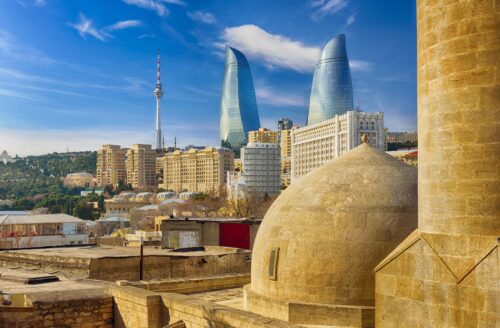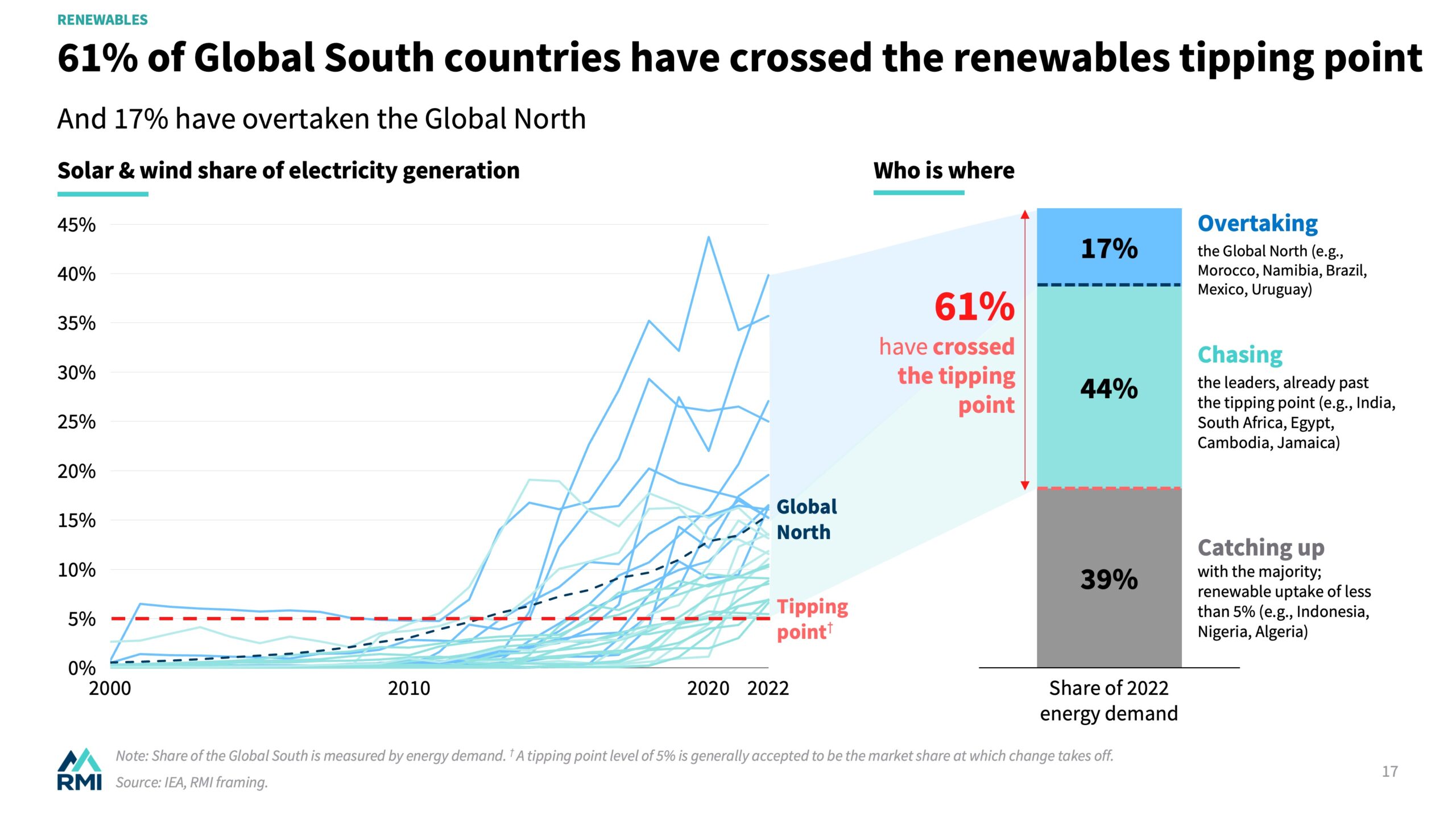
RMI’s Goals for COP29: Double Efficiency, Extend Finance, and Curtail Methane Leakage
World leaders are gathering in Baku, Azerbaijan, Nov. 11–22, to reckon with a split climate reality. The energy transition is advancing quickly, but damages from a warming planet are worsening.
In mid-November, nearly 50,000 climate professionals are expected to descend on Baku, the ancient capital of Azerbaijan, in central Asia, for COP29. Dubbed the “finance COP,” this year’s UN-hosted climate conference is a moment for wealthy countries in the Global North to show up and deliver for the Global South. The New Collective Quantified Goal on Climate Finance, an updated target of money flowing from developed to developing countries, is meant to fund the Global South’s transition to renewable energy while building resilience against an increasingly destructive climate.
Starting at the first Conference of Parties, or COP, in Berlin in 1995, the climate gathering has been held for governments to negotiate their shared commitments under the United Nations framework on climate change. Since then, each gathering has also seen a steadily growing presence from civil society, companies, and activists.
This November, RMI heads to COP29 in Baku with eyes wide open about the challenges to a fast and fair energy transition. But we remain unwavering in our belief that the renewables revolution is deeply established — and gaining speed. The solutions and technologies needed to end climate change are known and available to us. Political will and collective action, however, are not keeping pace.
Ahead of Baku, the UN released its Emissions Gap Report, an annual evaluation of progress to cut emissions — and the grade is failing. After countries closed COP28 with an agreement to “transition away from fossil fuels in energy systems,” fossil fuel consumption continues to rise, and emissions and global temperatures along with it. Under current policies, the world is on track to see a rise of 3.1°C (5.6°F) through 2100 over preindustrial temperatures. That’s nearly twice the low end of the Paris target of 1.5–2.0°C. To date, the world has already warmed by 1.3°C.
Higher temperatures will deliver even more intense and deadly climate impacts. From super storms to year-round wildfires, irreversible systemic effects of rising global temperatures are worsening and emerging ahead of schedule. Scientists recently sounded an alarm in the journal Nature documenting that the Amazon may be passing a vital tipping point far sooner than anticipated, as fire and drought convert the enormous rainforest from a global carbon sponge into a savannah and net contributor of carbon.
At the same time, COP29 comes ahead of the delivery of the next update of each country’s nationally determined contributions (NDCs 3.0), due in February 2025. As a basis for national policymaking and implementation, the NDCs can create the enabling environment for investment at scale. Effective national climate plans, designed to cover the next decade, can unlock trillions in private investment to protect our health and nature, scale cheap renewable energy, support industries to compete in a low-carbon economy, and safeguard living standards equitably for all people.
RMI in Baku
RMI’s team In Baku will be championing a message of radical implementation, especially in the areas of increasing energy efficiency worldwide, mobilizing finance for the Global South, curbing methane, and cleaning up heavy industry. Here’s what is top of mind for us heading into COP29:
Doubling down on energy efficiency is as important as tripling up renewables, and failing to deliver could slow progress on decarbonization by at least a decade. We are not doing enough to prioritize energy efficiency to prevent the $4.5 trillion wasted by an inefficient energy system. Whether trying to build more data centers, or electrify buildings, transportation, and industry, efficiency is the largest, cheapest, safest, cleanest, and fastest way to address the need for more energy.
Amory Lovins’ earliest work set up RMI as a champion of efficiency, demand reduction, and demand response as essential to a sustainable future. Energy efficiency is the engine that powers the transition, amplifying the growth of renewable energy and driving emissions reductions.
As then, efficiency remains one of the most potent and cost-effective approaches to cutting emissions. In 2022, energy efficiency saved more than three times as much primary energy as was added by the growth in solar and wind capacity, according to the International Energy Agency (IEA).
By 2030, achieving the doubling down on energy efficiency (2xEE) goal would bring about greater emissions reductions than any other component of the COP28 “energy package,” significantly accelerating the phaseout of fossil fuels, resulting in 10 percent lower energy demand in 2030 despite GDP growth of 25 percent, the IEA estimates. Overall, doubling energy efficiency could generate 40 percent of the 2100 emissions reductions targeted by the Paris Agreement.
In 2022, energy efficiency saved more than 3x as much primary energy as was added by the growth in solar and wind capacity.
Scaling blended finance. The head of the UN climate arm, Simon Stiell, recently called on all governments heading to Baku to agree on a new goal for international climate finance that benefits emerging and vulnerable economies.
The $100-million funding promise to low-income countries — made by major industrialized countries in Copenhagen's COP15 — was finally met in 2022, two years late. Heading into this finance-focused COP, a new goal must be set. Getting to a bigger number — expected to be in excess of $200 billion per year — will demand a mix of funds from private capital, country pledges, and multilateral financial institutions.
Ahead of Baku, Stiell called the gathering the “stand-and-deliver COP,” a chance to implement previous years’ commitments to mobilize finance from both public and private sources toward climate action, especially in the Global South. At the G20 in Brazil in early October, climate and finance ministers came together in an important acknowledgment of shared responsibility to save the global economy through climate finance.
At RMI, we enable blended finance — the combination of public and private capital — to flow to huge infrastructure updates such as switching from coal-fired electricity generation to renewable energy. We work on both the supply and demand sides of climate capital, increasing the supply of capital for decarbonization projects from blended finance while also de-risking novel energy transition investment opportunities. We collaborate with countries across the Global South, focusing on harnessing the power of clean energy to fuel economic growth.
Our recent research shows the incredible money-making potential of renewables across countries in the Global South. From Brazil to Morocco, Bangladesh to Vietnam, unexpected countries are using more solar and wind in electricity generation than their counterparts in the Global North. “The rapid growth of renewables provides the foundation for higher levels of electricity supply, which in turn will drive growth.”
Curtailing methane leakage. Methane, a climate pollutant that is some 80 times more potent than carbon dioxide over a 20-year period, is finally having its moment on the global stage. As RMI works with a partner network of satellite and sensor operators to make visible methane emissions from the oil and gas and waste sectors, the global community is stepping up efforts to cut these harmful, costly leaks. The COP29 Presidency plans to launch the Declaration on Reducing Methane from Organic Waste as a supplement to the Global Methane Pledge from 2021.
RMI’s thought leaders will also be championing the importance of incorporating methane into NDCs 3.0, an area where country climate plans typically fall short. We will use the COP platform to increase awareness for financing methane solutions and the growing need for capacity building across the many stakeholders trying to keep up with the rapid technology, policy, and market advances.
Establishing green iron corridors. Today, steelmaking accounts for about 11 percent of global CO2 emissions. To scale down this climate pollution, over a third of primary steelmaking will need to shift to be produced by clean hydrogen by 2050, according to a recent IEA analysis. Green iron corridors can help achieve this.
Iron, a precursor to steel is generally produced at the same facility where final steel is made, using a mix of coal and iron ore — a process which yields huge emissions of carbon. Thus, iron and steelmaking have historically centered in close proximity to sources of coal and iron ore.
Greener steelmaking methods are poised to shift that geography. Given that green steel’s cost competitiveness is driven more by the low cost of renewable energy, ironmaking will shift to new geographies rich in iron ore, low-cost renewables, and related supplies of green hydrogen. New projects in Sweden, where there is a combination of both high-quality ore and cost-competitive wind and hydropower energy, demonstrate this future direction.
Dividing the production of iron and steel could open new markets for regions with abundant ore but little steelmaking capability and accelerate world markets to low-emissions iron and steel production, helping to satisfy the growing demand for low-emissions steel.
The trade corridors that will emerge in these new geographies are called “green iron corridors.” For background on this initiative, see “Green Iron Corridors: A New Way to Transform the Steel Business.” At COP29, RMI will lead a session exploring the emerging trade dynamics for green iron corridors, bringing together key public and private actors from import and export regions.
Boosting demand for cleaner shipping fuels. Green hydrogen is likewise emerging as a vital option to swap out today’s heavy-emitting bunker fuels for clean alternatives, such as green ammonia or green methanol.
At COP29, industry leaders aim to build on the momentum from previous agreements to strengthen targets and commit to increasing the use of zero or near-zero-emission shipping fuels. In this area, RMI is working on solutions to address some of the shipping sector’s decarbonization challenges, namely high costs and fragmented availability of low-emissions fuels. Central to this goal is the development of a global book and claim system which can advance the shipping sector’s quest to decarbonize.
Local action, global impact
While a global framework for climate action is essential to ensure no one is left behind, RMI recognizes the limitations of the current UN system, and sees mobilization happening most rapidly in the private sector and at the state or city level. Instead of holding our breath for an earth-shattering consensus in Baku, we are focused on delivery at the state and community level, alongside companies and civil society.
